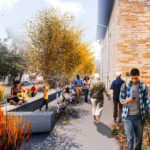City Commission undecided about East Ninth Project, votes to discuss it in coming weeks

A resting area has been proposed near the Turnhalle Building, at Ninth and Rhode Island streets, as part of the East Ninth project. This rendering, which looks east from the intersection, shows simple seating walls and native grasses.
After nearly four hours of hearing what Lawrence residents thought about the project to change East Ninth Street into an arts corridor, the City Commission — with not enough votes to move its design forward — voted to study it further in coming weeks.
Forty-one Lawrence business owners, artists and other residents spoke about the multimillion-dollar project Tuesday night, and dozens more onlookers filled the ground floor of City Hall. The meeting room and overflow area remained full until commissioners voted at 11 p.m. to hold a study session about the project. Sometime in coming weeks, they’ll go through its specifics, including funding and how much work should be done to the street.
“I’m at a point where I’d ask to move the concept design forward and go to phase two,” Mayor Mike Amyx said at the beginning of commission deliberations. “We can still help direct the scope of the project. We can do that if we move to phase two. It’s a great concept to work from.”
Commissioner Matthew Herbert issued his support of the project, saying the project’s goals aligned with what East Lawrence laid out in its revitalization plan in 2000.
“This isn’t us versus them,” Herbert said. “The neighborhood revitalization plan calls for this, and it called for this 16 years ago.”
But Commissioners Stuart Boley and Lisa Larsen said they had concerns about the design and weren’t ready to vote. Vice Mayor Leslie Soden, who has been critical of the project in the past, remained mostly silent. She said only that the funding wasn’t available and she wouldn’t vote to raise taxes for it.
Boley said he wasn’t sure the entire six-block corridor needed reconstructing. Larsen expressed worry about parking, an issue reiterated by those opposing the project Tuesday.
“I think it needs compromise,” Larsen said. “That’s what I would like to see: more compromise.”
The budget was also brought into question.
Porter Arneill, director of arts and culture for the city, said the project, first estimated to cost approximately $2.7 million and more recently $3.5 million, would be between $3.6 million and $3.7 million, accounting for funds for phase two — the technical designs.
In a draft of Lawrence’s five-year capital improvement plan, City Manager Tom Markus listed the project as going unfunded in 2017. The move prompted a response from the Lawrence Arts Center, which was awarded a $500,000 grant for the project in 2014.
More from Tuesday’s City Commission meeting
? Commissioners told to expedite decisions on new police headquarters
Markus said at a budget work session Tuesday that if commissioners were to move the project forward, they should identify what to take away from the capital plan in order to fund it.
“If you decide to issue the funding, that would mean we’d have to go into the CIP and pull it out in other items we’ve recommended for funding,” Markus said. “I did not include it in the CIP; that’s on me. That was my decision.”
Thirteen of those who spoke about the project at Tuesday’s meeting opposed it. They had concerns about parking and its expense, among other things.
The remaining speakers, 28 people, said it would transform the street for the better.
“I think the city of Lawrence needs to figure out what kind of city of Lawrence it wants to be,” said project designer Josh Shelton, of el dorado inc. “Clearly, this is a pivotal moment. We wanted to zoom out and set forth something that is visionary.”
The current design includes two driving lanes for most of the six-block corridor, along with sidewalks on each side and an 8-foot shared-used path for both pedestrians and bicyclists. Parallel parking would be available in places on both sides of Ninth Street.
Components for the project include light displays, sound signals, native grasses used for stormwater management and large rocks arranged to create intimate gathering areas. The full concept design is outlined in an 81-page report.






